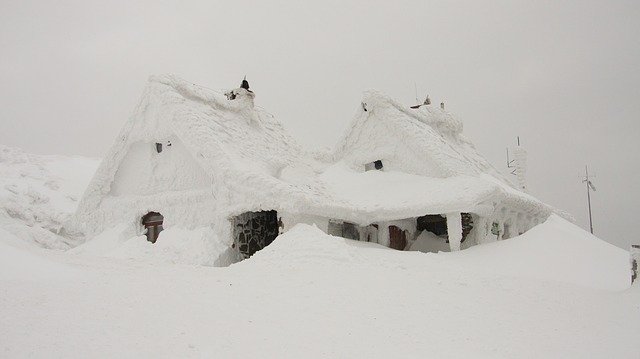The switch from fall to winter is often a quick one. Strong winds are blowing across town, and snow is piling up on your house before you know it. With the cold weather in full swing, it’s worth thinking about the aftermath of a potential blizzard.
Proper blizzards have certain characteristics:
- Three or more hours of winds above 56 km/hour
- Visibility reduced to 0.25m from drifting snow and blowing wind
- Fierce weather chills
They also bring freezing rain, slush, and seriously low temperatures. Once a blizzard hits, there can be several types of damage that you will need to address.
Impact of Blizzards
Blizzards can last up to a full week with constant snowing and fierce winds. Some result in a complete whiteout, which happens when endless snow falling obstructs visibility in the blizzard-struck area. This can have disastrous consequences for homeowners who have a long commute to work or their children’s school.
The snowstorm can also cause damage to your property. Watch out for:
Roof collapse
The weight of snow may cause your roof to collapse, resulting in expensive repairs. Plus, plummeting temperatures can turn the water and debris in the pipes around your roof into ice and slush, pausing the flow and generating a backup. This can cause the drains to split and damage the top of your house.
Hidden structural damage
Often, blizzards will cause ice and snow to accumulate on your roof, which might not be visible to the naked eye. As temperature changes throughout the day, these patches will melt and then refreeze. The water that surfaces can seep into our siding, brickwork, and even ceiling joints, silently damaging the structural integrity of your home.
Downed trees and power lines
Strong winds and blowing snow can snap tree branches in a jiffy, downing power lines in the process. Never attempt to remove the debris near them. Get in touch with a disaster restoration company for any damaged electrical components to be removed professionally. If your area has recently experienced a blizzard, look out for power lines in and around your yard. Also, make sure your carbon monoxide is working – most homes lose electricity during a blizzard and must burn fuel inside to keep the temperature warm.
Basement damage
When the storm gradually begins to subside, ice runoff and melting snow can soak yards and occupy street gutters. Also, the soil present near your home’s foundation can become saturated with moisture that makes its way into your basement through the cracks. Flooding in the basement isn’t an uncommon phenomenon for homeowners based in storm-prone localities. Utah flood cleanup specialists can help mitigate the damages.
Shingles and flashing destruction
A fierce blizzard can shut a city down with winds gusting between 30 to 50 miles per hour. Watch out for airborne projectiles like trash cans and lawn chairs because that kind of force can easily turn such objects into a destructible force. Plus, the same velocity can peel back flashing and rip off loose shingles. If you aren’t prepared, the force can make your property vulnerable to water damage ranging from breaches in the roof underlayment to leaks in the attic.
Insulated pipe damage
No matter how confident you are in your home’s plumbing, dropping temperatures can cause it to turn into ice. The insulated pipes expand and raise problems ranging from tiny leaks to complete plumbing failure. And the water damage that follows can be severe and costly to address.
Protecting Your Home Against Blizzard Damage
Fortunately, there are ways to make your home resilient against blizzards. Here is what you can do:
- When you get the news, trim the tree branches that might damage structures if they break due to the snow’s weight. Next, clean out any downspouts and debris to make way for snowmelt. It’s also a good idea to store or fasten down any patio and yard items that could become projectiles as the wind picks up speed. Moreover, you should slightly open exterior faucets (to avoid harm from frozen pipes) and make flashlights accessible in case of power outages.
- A month or two before the cold season, winterize your property by insulating pipes, walls, basements, and attics. Check your furnace and ensure it is working at an efficient capacity. Another critical measure is to replace any cracked windows and caulk the cracks in the walls to prevent runoff water from seeping through these spaces.
- Invest in a shovel and ice melt. While these two products may not address the serious issues resulting from a blizzard, they will make your life easier. The key to blizzard restoration lies in addressing the problems early. This means shoveling snow off the driveway and away from your property and laying down ice melt quickly and frequently. These are relatively simple measures that can save you a lot of repairs in the long run. So, stock up on ice melt and see if you can get some durable, lightweight shovels off of Amazon.
- Once the storm passes, evaluate the snowpack on your roof and call in a professional if necessary. Disaster restoration experts can remove snow from outdoor meters for water, electricity, and gas.
Besides taking these steps, it’s recommended that you stay inside your home. Going out in a blizzard is an unpleasant experience that could even result in a fatality. Being caught in a heavy snowstorm, unprepared, or unprotected, could cause frostbite, hypothermia, or death. The best way to prevent these occurrences is to keep yourself inside your home.
You can turn to the National Weather Service to keep tabs on approaching snowstorms or blizzards. They regularly issue a blizzard watch or a blizzard warning that can help you take all the steps to protect your home.

